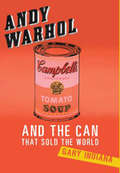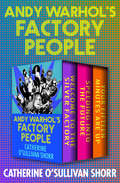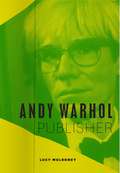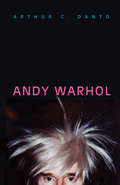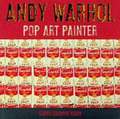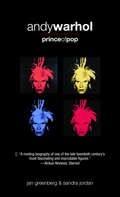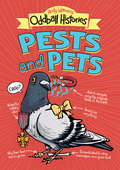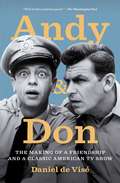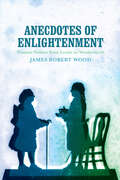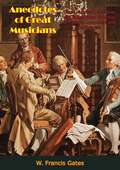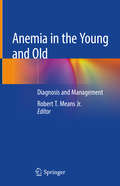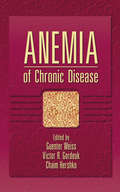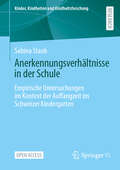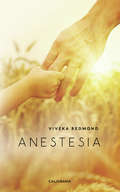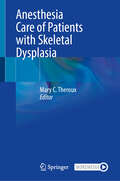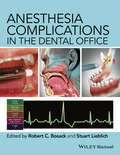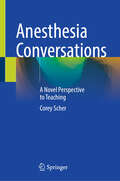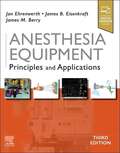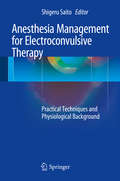- Table View
- List View
Andy Warhol and the Can That Sold the World
by Gary IndianaIn the summer of 1962, Andy Warhol unveiled 32 Soup Cans in his first solo exhibition at the Ferus Gallery in Los Angeles-and sent the art world reeling. The responses ran from incredulity to outrage; the poet Taylor Mead described the exhibition as "a brilliant slap in the face to America. ” The exhibition put Warhol on the map-and transformed American culture forever. Almost single-handedly, Warhol collapsed the centuries-old distinction between "high” and "low” culture, and created a new and radically modern aesthetic. InAndy Warhol and the Can that Sold the World, the dazzlingly versatile critic Gary Indiana tells the story of the genesis and impact of this iconic work of art. With energy, wit, and tremendous perspicacity, Indiana recovers the exhilaration and controversy of the Pop Art Revolution and the brilliant, tormented, and profoundly narcissistic figure at its vanguard.
Andy Warhol's Factory People: Welcome to the Silver Factory, Speeding into the Future, and Your Fifteen Minutes Are Up (Andy Warhol's Factory People #2)
by Catherine O'Sullivan ShorrBased on the television documentary: A three-part oral history of the Pop Art sensation&’s inner circle and their dazzling world of art, drugs, and drama. Featuring a new introduction by the author, special to this collection, this three-part companion volume to Emmy Award–winning Catherine O&’Sullivan Shorr&’s documentary Andy Warhol&’s Factory People is an unprecedented exposé of an exhilarating and tumultuous time in the 1960s New York City art world—told by the artists, actors, writers, musicians, and hangers-on who populated and defined the Factory. &“Different [in] its avowed bottom-up approach: Warhol as a function of his followers is the idea. This time . . . it&’s the interviews that tell the tale&” (Robert Lloyd, Los Angeles Times). Welcome to the Silver Factory: In 1962, frustrated with advertising work, Warhol sets up his legendary studio in an abandoned hat factory on Manhattan&’s 47th Street. The &“Silver Factory&” quickly becomes the hub of Warhol&’s creative endeavors—the space where he constantly works while an ever-changing cast of characters and muses passes through with their own contributions. Speeding into the Future: In a peak period from 1965 through 1966, Warhol creates the notion of the &“It Girl&” with ingenuous debutante Edie Sedgwick; discovers Lou Reed, the Velvet Underground, and Nico, the gorgeous chanteuse who becomes his next &“It Girl&”; and directs—with Paul Morrissey—his most commercially successful film, the art house classic, Chelsea Girls. Your Fifteen Minutes Are Up: By 1967, it seems that the Factory has outlived its fifteen minutes of fame. Superstars like Edie Sedgwick fall victim to drugs. Factory denizens have falling-outs with Warhol, as do the Velvet Underground, who are also caught up in disputes of their own. Into the chaos comes radical feminist Valerie Solanas, who shoots Warhol and seriously injures him. He survives—barely—but the artist, and his art, are forever changed.
Andy Warhol, Publisher
by Lucy MulroneyAlthough we know him best as a visual artist and filmmaker, Andy Warhol was also a publisher. Distributing his own books and magazines, as well as contributing to those of others, Warhol found publishing to be one of his greatest pleasures, largely because of its cooperative and social nature. Journeying from the 1950s, when Warhol was starting to make his way through the New York advertising world, through the height of his career in the 1960s, to the last years of his life in the 1980s, Andy Warhol, Publisher unearths fresh archival material that reveals Warhol’s publications as complex projects involving a tantalizing cast of collaborators, shifting technologies, and a wide array of fervent readers. Lucy Mulroney shows that whether Warhol was creating children’s books, his infamous “boy book” for gay readers, writing works for established houses like Grove Press and Random House, helping found Interview magazine, or compiling a compendium of photography that he worked on to his death, he readily used the elements of publishing to further and disseminate his art. Warhol not only highlighted the impressive variety in our printed culture but also demonstrated how publishing can cement an artistic legacy.
Andy Warhol: 21 Segi Changjojeok Injaeeui Rolmodel = [andy Warhol] (Icons of America #12)
by Arthur C. Danto&“Astutely traces the ripple effects of Warhol&’s blurring of the lines between commercial and fine art, and art and real life…masterful.&”—Booklist (starred review) Art critic, philosopher, and winner of a National Book Critics Circle Award Arthur Danto delivers a compact, masterful tour of Andy Warhol&’s personal, artistic, and philosophical transformations. Danto traces the evolution of the pop artist, including his early reception, relationships with artists such as Jasper Johns and Robert Rauschenberg, and the Factory phenomenon. He offers close readings of individual Warhol works, including their social context and philosophical dimensions, key differences with predecessors such as Marcel Duchamp, and parallels with successors like Jeff Koons. By drawing on subject matter understandable to the ordinary American, Warhol revolutionized the way we look at art. In this book, Danto brings to bear encyclopedic knowledge of Warhol&’s time and shows us Warhol as an endlessly multidimensional figure—artist, political activist, filmmaker, writer, philosopher—who retains permanent residence in our national imagination.
Andy Warhol: A Biography (LIVES #2)
by Wayne Koestenbaum'Properly analytical ... always entertaining' TIME OUT'Should tempt both those generally familiar with Andy Warhol and, even more, young people who have trouble imagining how popular art can challenge the status quo' L A TIMESPainter, filmmaker, photographer, philosopher, all-round celebrity, Andy Warhol is an outstanding cultural icon. He revolutionised art by bringing to it images from popular culture - such as the Campbell's soup can and Marilyn Monroe's face - while his studio, the Factory, where his free-spirited cast of 'superstars' mingled with the rich and famous, became the place of origin for every groundswell shaping American culture.In many ways he can be seen as the precursor to today's 'celebrity artists' such as Tracey Emin and Damian Hurst. But what of the man behind the white wig and dark glasses? Koestenbaum gives a fascinating, revealing and thought-provoking picture of pop art's greatest icon.
Andy Warhol: A Biography (Lives Ser.)
by Wayne KoestenbaumAn intimate depiction of the visionary who revolutionized the art world A man who created portraits of the rich and powerful, Andy Warhol was one of the most incendiary figures in American culture, a celebrity whose star shone as brightly as those of the Marilyns and Jackies whose likenesses brought him renown. Images of his silvery wig and glasses are as famous as his renderings of soup cans and Brillo boxes—controversial works that elevated commerce to high art. Warhol was an enigma: a partygoer who lived with his mother, an inarticulate man who was a great aphorist, an artist whose body of work sizzles with sexuality but who considered his own body to be a source of shame. In critic and poet Wayne Koestenbaum&’s dazzling look at Warhol&’s life, the author inspects the roots of Warhol&’s aesthetic vision, including the pain that informs his greatness, and reveals the hidden sublimity of Warhol&’s provocative films. By looking at many facets of the artist&’s oeuvre—films, paintings, books, &“Happenings&”—Koestenbaum delivers a thought-provoking picture of pop art&’s greatest icon.
Andy Warhol: Pop Art Painter
by Susan Goldman RubinFollowing award-winning artist biographies "Degas and the Dance," "Toulouse-Lautrec," and "Cezanne," an exciting new book from Abrams Books for Young Readers looks at Andy Warhol. A leader of the American art movement known as Pop, short for "popular culture," Warhol changed the way we think of art. Assisted by photographs taken of Warhol throughout his life, and examples of his early drawings and best-known works, Susan Goldman Rubin traces his rise from poverty to wealth, and from obscurity to fame.
Andy Warhol: Prince of Pop
by Jan Greenberg Sandra JordanThe Campbell’s Soup Cans. The Marilyns. The Electric Chairs. The Flowers. The work created by Andy Warhol elevated everyday images to art, ensuring Warhol a fame that has far outlasted the 15 minutes he predicted for everyone else. His very name is synonymous with the 1960s American art movement known as Pop. But Warhol’s oeuvre was the sum of many parts. He not only produced iconic art that blended high and popular culture; he also made controversial films, starring his entourage of the beautiful and outrageous; he launched Interview, a slick magazine that continues to sell today; and he reveled in leading the vanguard of New York’s hipster lifestyle. The Factory, Warhol’s studio and den of social happenings, was the place to be. Who would have predicted that this eccentric boy, the Pittsburgh-bred son of Eastern European immigrants, would catapult himself into media superstardom? Warhol’s rise, from poverty to wealth, from obscurity to status as a Pop icon, is an absorbing tale—one in which the American dream of fame and fortune is played out in all of its success and its excess. No artist of the late 20th century took the pulse of his time—and ours—better than Andy Warhol.
Andy Warner's Oddball Histories: Pests and Pets (Andy Warner's Oddball Histories)
by Andy WarnerThe bestselling author of Brief History of Everyday Objects explores the animals we love, the ones we make use of, and the ones that make use of us in this hilarious, informative mix of storytelling and factbook.Did you know that 32 pigeons have received medals for wartime valor? And a dog named Laika was the very first creature in space? Did you know that there is an island in Japan entirely overrun by bunnies? And -- for a brief time -- rats adorned with ribbons were a popular lap pet in upper-class London? In Andy Warner's Oddball Histories: Pests and Pets, you can find out more than you ever thought possible about creatures both cute and weird, both large and small, while discovering new stories about human history from the perspective of our animal companions. Did you know that bees communicate with each other using special dances? Or that a popular anime called Rascal the Racoon may be largely responsible for Japan's huge raccoon population? Packed with incredible facts and charming stories like these, this is the perfect book for curious readers.
Andy and Don: The Making of a Friendship and a Classic American
by Daniel De ViséA lively and revealing biography of Andy Griffith and Don Knotts, celebrating the powerful real-life friendship behind one of America's most iconic television programs.Andy Griffith and Don Knotts met on Broadway in the 1950s. When Andy went to Hollywood to film a TV pilot about a small-town sheriff, Don called to ask if the sheriff could use a deputy. The comedic synergy between Sheriff Andy Taylor and Deputy Barney Fife ignited The Andy Griffith Show, elevating a folksy sitcom into a timeless study of human friendship, as potent off the screen as on. Andy and Don--fellow Southerners born into poverty and raised among scofflaws, bullies, and drunks--captured the hearts of Americans across the country as they rocked lazily on the front porch, meditating about the simple pleasure of a bottle of pop. But behind this sleepy, small-town charm, de Visé's exclusive reporting reveals explosions of violent temper, bouts of crippling neurosis, and all-too-human struggles with the temptations of fame. Andy and Don chronicles unspoken rivalries, passionate affairs, unrequited loves, and friendships lost and regained. Although Andy and Don ended their Mayberry partnership in 1965, they remained best friends for the next half-century, with Andy visiting Don at his death bed. Written by Don Knotts's brother-in-law and featuring extensive unpublished interviews with those closest to both men, Andy and Don is the definitive literary work on the legacy of The Andy Griffith Show and a provocative and an entertaining read about two of America's most enduring stars.
Anecdotes from a Diplomat's Life
by P. J. Rao"A gentle self-deprecating humour pervades his writing ... I express the hope that all the readers of this charming book will enjoy reading it as much as I myself have done." -A.P. Venkateswaran (Former Foreign Secretary) Government of India
Anecdotes of Enlightenment: Human Nature from Locke to Wordsworth
by James Robert WoodAnecdotes of Enlightenment is the first literary history of the anecdote in English. In this wide-ranging account, James Robert Wood explores the animating effects anecdotes had on intellectual and literary cultures over the long eighteenth century. Drawing on extensive archival research and emphasizing the anecdote as a way of thinking, he shows that an intimate relationship developed between the anecdote and the Enlightenment concept of human nature. Anecdotes drew attention to odd phenomena on the peripheries of human life and human history. Enlightenment writers developed new and often contentious ideas of human nature through their efforts to explain these anomalies. They challenged each other’s ideas by reinterpreting each other’s anecdotes and by telling new anecdotes in turn.Anecdotes of Enlightenment features careful readings of the philosophy of John Locke and David Hume; the periodical essays of Joseph Addison, Richard Steele, and Eliza Haywood; the travel narratives of Joseph Banks, James Cook, and James Boswell; the poetry of Samuel Taylor Coleridge and William Wordsworth; and Laurence Sterne’s Tristram Shandy. Written in an engaging style and spotlighting the eccentric aspects of Enlightenment thought, this fascinating book will appeal to historians, philosophers, and literary critics interested in the intellectual culture of the long eighteenth century.
Anecdotes of Great Musicians: Three Hundred Anecdotes and Biographical Sketches of Famous Composers and Performers
by W. Francis GatesThis book, which was first published in 1895, is a wonderful collection of some 300 anecdotes and biographical sketches of famous composers and performers since time began.In the author’s own words, “[I]n the search for what this volume comprises, much material has been examined. I have attempted to cull from the mass of material that came to my notice such anecdotes as have two features,—that of being characteristic of the person referred to, and that of possessing sufficient interest; and in this re-narration I have incorporated such bits of musical information, along biographical and historical lines, as came to mind at the time of writing, but letting this feature be secondary to the main idea of the work. Thus it is hoped that while my readers may find interesting anecdote, they may also incidentally find that which is of more permanent value.”Gates’ work may be regarded as a companion volume to his book Musical Mosaics (1889), “supplementing the thoughts of the great musicians there expressed with incidents giving somewhat of a clue to their personality.”
Anecdotes of the Cynics (Penguin Little Black Classics)
by Robert Dobbin'It's you who are the dogs...'
Anechoic and Reverberation Chambers: Theory, Design, and Measurements (Wiley - IEEE)
by Yi Huang Qian XuA comprehensive review of the recent advances in anechoic chamber and reverberation chamber designs and measurements Anechoic and Reverberation Chambers is a guide to the latest systematic solutions for designing anechoic chambers that rely on state-of-the-art computational electromagnetic algorithms. This essential resource contains a theoretical and practical understanding for electromagnetic compatibility and antenna testing. The solutions outlined optimise chamber performance in the structure, absorber layout and antenna positions whilst minimising the overall cost. The anechoic chamber designs are verified by measurement results from Microwave Vision Group that validate the accuracy of the solution. Anechoic and Reverberation Chambers fills this gap in the literature by providing a comprehensive reference to electromagnetic measurements, applications and over-the-air tests inside chambers. The expert contributors offer a summary of the latest developments in anechoic and reverberation chambers to help scientists and engineers apply the most recent technologies in the field. In addition, the book contains a comparison between reverberation and anechoic chambers and identifies their strengths and weaknesses. This important resource: • Provides a systematic solution for anechoic chamber design by using state-of-the-art computational electromagnetic algorithms • Examines both types of chamber in use: comparing and contrasting the advantages and disadvantages of each • Reviews typical over-the-air measurements and new applications in reverberation chambers • Offers a timely and complete reference written by authors working at the cutting edge of the technology • Contains helpful illustrations, photographs, practical examples and comparison between measurements and simulations Written for both academics and industrial engineers and designers, Anechoic and Reverberation Chambers explores the most recent advances in anechoic chamber and reverberation chamber designs and measurements.
Anemia in the Young and Old: Diagnosis and Management
by Robert T. Means Jr.This text provides a concise yet comprehensive overview of anemia in the young and old. The first section of the volume features age-specific diagnostic approaches to anemia, from the perinatal period to the elderly, with a particular emphasis on age-specific epidemiology, differential diagnosis, and testing. The second section focuses on specific anemia disorders, including inherited bone marrow failure syndromes, iron deficiency anemia, renal anemia, pure red cell anemia, and anemia of inflammation and chronic disease. Each chapter in this section revolves around a specific syndrome or group of syndromes, and addresses pathophysiology, diagnostic issues, natural history/prognosis, and treatment. Written by experts in the field, Anemia in the Young and Old: Diagnosis and Management is a valuable resource for clinicians and practitioners who treat the pediatric and elderly patient population afflicted with anemia.
Anemia of Chronic Disease (Basic and Clinical Oncology)
by Günter Weiss Victor R. Gordeuk Chaim HershkoThis book summarizes the most current research on the anemia of chronic disease and identifies effective diagnostic strategies for this common clinical condition-covering key topics related to the design and selection of therapeutic options including the treatment of the underlying disease, the biology of erythropoietin and the regulation of erythr
Anerkennungsverhältnisse in der Schule: Empirische Untersuchungen im Kontext der Auffangzeit im Schweizer Kindergarten (Kinder, Kindheiten und Kindheitsforschung #33)
by Sabina StaubIn diesem Open-Access-Buch werden rekonstruierbare Normen zur Diskussion gestellt, innerhalb derer Kinder zu Kindergarten- und Schulkindern werden und die in der Regel nicht reflexiv zugänglich sind. Um herauszufinden, welche Anerkennungsverhältnisse sich zwischen Lehrpersonen und Kindern im Kindergarten manifestieren, wurden videografierte Interaktionen während der sogenannten Auffangzeit und Interviews mit Kindergartenlehrpersonen mit der dokumentarischen Methode analysiert. Die Analysen ergeben, dass in diverse Praktiken der Lehrpersonen eine generationale Ordnung hergestellt wird und dass der Entwicklungsstand der Kinder und das Bild der Kindergartenkinder als zukünftige Erwachsene die Anerkennungsverhältnisse bestimmen. Durch den Vergleich von zwei Lehrpersonen kann aufgezeigt werden, dass bei der Begrüßung der Kinder die Norm der ordnungsgemäßen Durchführung von Aufträgen betont und aktualisiert wird. Die Kinder werden als unterstützungsbedürftige Interaktionsteilnehmende adressiert. Während der normative Horizont in einem der beiden Kindergärten anschließend zum aktiven und gestaltenden Umgang mit dem vorbereiteten Spiel- und Lernangebot wechselt und die Kinder als kompetente Mitgestaltende adressiert werden, verändert sich bei der anderen Lehrperson die vorherrschende Norm nicht.
Anestesia
by Viveka RedmondTendría mucho que decirte, pero no quiero hacerlo con tinta y pluma. Espero verte pronto y hablar cara a cara. Anestesiarnos. Quedarnos dormidos hasta que la herida se haya cerrado por completo. Hasta que deje de doler. Y si lo aplicamos al cuerpo, ¿cómo no tratar de hacer lo propio con el alma cuando la vida nos pone a prueba? Colocamos parches encima de cada roto. Hacemos remiendos con agujas sin hilo. Cualquier alternativa antes que encarar nuestra debilidad. Antes que mirarla a los ojos. Anestesia es un canto a la esperanza frente a las dificultades, entonado en clave de amor verdadero. Ese que pasamos toda la vida buscando. Ese que nos da fuerza. El que lleva la paz a la confusión. El que da sentido a todo. A pesar de todo. Un viaje a través de los sentimientos fundamentado sobre la fuerza del perdón, que refleja determinadas alternativas con las que, en ocasiones, tratamos de enfrentar e incluso evitarel sufrimiento.
Anesthesia Care of Patients with Skeletal Dysplasia
by Mary C. TherouxPatients with skeletal dysplasia are at greater risk for adverse events, including death, during or shortly after their anesthetic care. Due to advancements in medical and surgical treatment modalities, patients with skeletal dysplasia now enjoy a longer life span, emphasizing the importance of broader awareness and deeper understanding of the specialized anesthetic management required to ensure their safety and successful outcomes. This book provides a comprehensive overview of anesthetic care and management tailored specifically towards various forms of skeletal dysplasia. The chapters are organized into sections that focus on the different forms of skeletal dysplasia and their associated co-morbidities. They provide insights on how to anticipate and manage potential complications that may occur during the anesthetic care of these complex medical patients. Additionally, the book highlights the patient&’s perspective, shedding light on the challenges individuals with skeletal dysplasia encounter in accessing appropriate anesthesia care. Intended primarily for practitioners of anesthesia, sedation, and critical care, this publication also serves as a resource for individuals with skeletal dysplasia who require anesthesia care. An understanding of the anesthesia process by the patients and families enables them to choose optimal care for a successful outcome.
Anesthesia Complications in the Dental Office
by Stuart Lieblich Robert BosackAnesthetic complications, which range from simple annoyances to patient mortality, are inevitable, given the many and complex interactions of doctor, patient, personnel, and facility. Anesthesia Complications in the Dental Office helps dentists minimize the frequency and severity of adverse events by providing concise and clinically relevant information that can be put to everyday use. Anesthesia Complications in the Dental Office presents the most up-to-date information on treating anesthesia complications and medical emergencies. Drs. Bosack and Lieblich and a team of expert contributors discuss patient risk assessment; considerations for special needs and medically compromised patients; routinely administered anesthetic agents; adversities that can arise before, during, and after administration of anesthesia; and emergency drugs and equipment. A must-have reference for every dental office.
Anesthesia Conversations: A Novel Perspective to Teaching
by Corey ScherThis book presents a variety of challenging anesthesia cases that are based on the author's extensive clinical experience and his ongoing mission to learn. The premise is the rebuilding of the department of anesthesiology in post-hurricane Katrina, New Orleans. The structure of the book follows a unique fictional format that reads more like a fictional mystery novel with complex anesthesia cases embedded in the fictional story. The book's goal is to increase the reader's memory of the basic fundamentals of case management in this unique format.
Anesthesia Equipment: Principles And Applications
by James B. Eisenkraft Jan Ehrenwerth James M. BerryOffering highly visual, easy-to-read coverage of the full range of anesthesia equipment in use today, this authoritative reference is your go-to text for objective, informed answers to ensure optimal patient safety. Anesthesia Equipment, 3rd Edition, provides detailed information on the intricate workings of each device or workstation, keeping you fully up to date and helping you meet both equipment and patient care challenges.
Anesthesia Management for Electroconvulsive Therapy: Practical Techniques and Physiological Background
by Shigeru SaitoIn this book, recognized anesthesiology experts present the latest findings on anesthesia for electro-convulsive therapy (ECT). With the development of modified electroconvulsive therapy (m-ECT) and devices to provide brief-pulse stimulation, ECT is currently being re-evaluated as an important procedure in psychiatric disorder therapy and is increasingly being used worldwide to treat several psychiatric conditions. This trend is due to the social phenomenon of the growing number of patients for whom ECT is applicable. Since the new approach is more safe and effective than the original method without anesthesia, m-ECT is currently applied under general anesthesia in most advanced countries. This book provides an overview and practice of total anesthesia management in the perioperative period of ECT. It offers an indispensable resource not only for professional anesthesiologists but also healthcare professionals who use this therapy.
